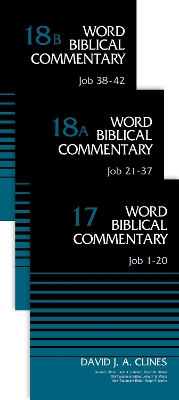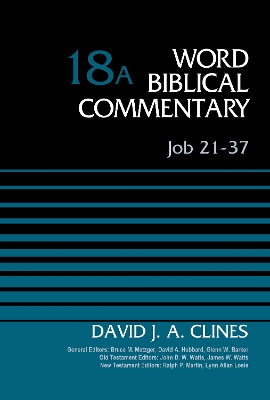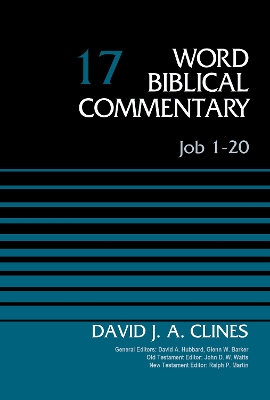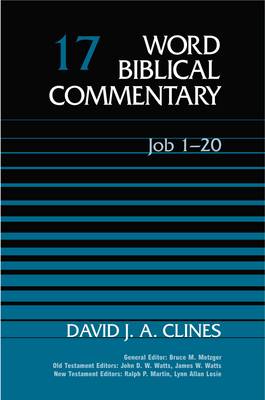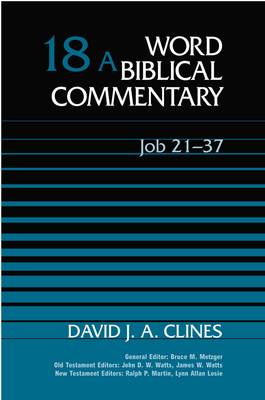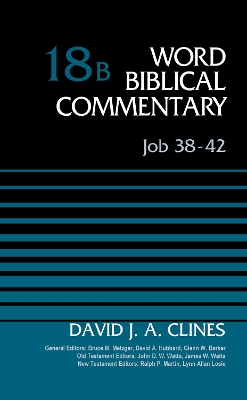Word Biblical Commentary
7 total works
The Word Biblical Commentary delivers the best in biblical scholarship, from the leading scholars of our day who share a commitment to Scripture as divine revelation. This series emphasizes a thorough analysis of textual, linguistic, structural, and theological evidence. The result is judicious and balanced insight into the meanings of the text in the framework of biblical theology. These widely acclaimed commentaries serve as exceptional resources for the professional theologian and instructor, the seminary or university student, the working minister, and everyone concerned with building theological understanding from a solid base of biblical scholarship.
Overview of Commentary Organization
- Introduction—covers issues pertaining to the whole book, including context, date, authorship, composition, interpretive issues, purpose, and theology.
- Each section of the commentary includes:
- Pericope Bibliography—a helpful resource containing the most important works that pertain to each particular pericope.
- Translation—the author’s own translation of the biblical text, reflecting the end result of exegesis and attending to Hebrew and Greek idiomatic usage of words, phrases, and tenses, yet in reasonably good English.
- Notes—the author’s notes to the translation that address any textual variants, grammatical forms, syntactical constructions, basic meanings of words, and problems of translation.
- Form/Structure/Setting—a discussion of redaction, genre, sources, and tradition as they concern the origin of the pericope, its canonical form, and its relation to the biblical and extra-biblical contexts in order to illuminate the structure and character of the pericope. Rhetorical or compositional features important to understanding the passage are also introduced here.
- Comment—verse-by-verse interpretation of the text and dialogue with other interpreters, engaging with current opinion and scholarly research.
- Explanation—brings together all the results of the discussion in previous sections to expose the meaning and intention of the text at several levels: (1) within the context of the book itself; (2) its meaning in the OT or NT; (3) its place in the entire canon; (4) theological relevance to broader OT or NT issues.
- General Bibliography—occurring at the end of each volume, this extensive bibliographycontains all sources used anywhere in the commentary.
Features include: * Complete new translation and verse by verse commentary on the Book of Job, in constant dialogue with other commentators * Extensive scholarly notes on the Hebrew text of the book and its many obscure terms * Unparalleled bibliography gives sweeping coverage of all aspects of the Book of Job from scholarly books to art, literature, and music
The Word Biblical Commentary delivers the best in biblical scholarship, from the leading scholars of our day who share a commitment to Scripture as divine revelation. This series emphasizes a thorough analysis of textual, linguistic, structural, and theological evidence. The result is judicious and balanced insight into the meanings of the text in the framework of biblical theology. These widely acclaimed commentaries serve as exceptional resources for the professional theologian and instructor, the seminary or university student, the working minister, and everyone concerned with building theological understanding from a solid base of biblical scholarship.
Overview of Commentary Organization
- Introduction—covers issues pertaining to the whole book, including context, date, authorship, composition, interpretive issues, purpose, and theology.
- Each section of the commentary includes:
- Pericope Bibliography—a helpful resource containing the most important works that pertain to each particular pericope.
- Translation—the author’s own translation of the biblical text, reflecting the end result of exegesis and attending to Hebrew and Greek idiomatic usage of words, phrases, and tenses, yet in reasonably good English.
- Notes—the author’s notes to the translation that address any textual variants, grammatical forms, syntactical constructions, basic meanings of words, and problems of translation.
- Form/Structure/Setting—a discussion of redaction, genre, sources, and tradition as they concern the origin of the pericope, its canonical form, and its relation to the biblical and extra-biblical contexts in order to illuminate the structure and character of the pericope. Rhetorical or compositional features important to understanding the passage are also introduced here.
- Comment—verse-by-verse interpretation of the text and dialogue with other interpreters, engaging with current opinion and scholarly research.
- Explanation—brings together all the results of the discussion in previous sections to expose the meaning and intention of the text at several levels: (1) within the context of the book itself; (2) its meaning in the OT or NT; (3) its place in the entire canon; (4) theological relevance to broader OT or NT issues.
- General Bibliography—occurring at the end of each volume, this extensive bibliographycontains all sources used anywhere in the commentary.
The Word Biblical Commentary delivers the best in biblical scholarship, from the leading scholars of our day who share a commitment to Scripture as divine revelation. This series emphasizes a thorough analysis of textual, linguistic, structural, and theological evidence. The result is judicious and balanced insight into the meanings of the text in the framework of biblical theology. These widely acclaimed commentaries serve as exceptional resources for the professional theologian and instructor, the seminary or university student, the working minister, and everyone concerned with building theological understanding from a solid base of biblical scholarship.
Overview of Commentary Organization
- Introduction—covers issues pertaining to the whole book, including context, date, authorship, composition, interpretive issues, purpose, and theology.
- Each section of the commentary includes:
- Pericope Bibliography—a helpful resource containing the most important works that pertain to each particular pericope.
- Translation—the author’s own translation of the biblical text, reflecting the end result of exegesis and attending to Hebrew and Greek idiomatic usage of words, phrases, and tenses, yet in reasonably good English.
- Notes—the author’s notes to the translation that address any textual variants, grammatical forms, syntactical constructions, basic meanings of words, and problems of translation.
- Form/Structure/Setting—a discussion of redaction, genre, sources, and tradition as they concern the origin of the pericope, its canonical form, and its relation to the biblical and extra-biblical contexts in order to illuminate the structure and character of the pericope. Rhetorical or compositional features important to understanding the passage are also introduced here.
- Comment—verse-by-verse interpretation of the text and dialogue with other interpreters, engaging with current opinion and scholarly research.
- Explanation—brings together all the results of the discussion in previous sections to expose the meaning and intention of the text at several levels: (1) within the context of the book itself; (2) its meaning in the OT or NT; (3) its place in the entire canon; (4) theological relevance to broader OT or NT issues.
- General Bibliography—occurring at the end of each volume, this extensive bibliographycontains all sources used anywhere in the commentary.
The Book of Job, among the greatest masterpieces of world literature, deserves a commentary alert both to the windings of its arguments and to the massive theological problem it raises: the conflict of faith and experience, that is, does it have to do primarily with the why of suffering, or is the chief issue rather the problem of the moral order of the world, of the principles on which it is governed?
While many feel that Job is too long, full of windy and tedious words, Professor David J .A. Clines shows in detail how every element is essential and how only the interweaving of literary and theological perspectives can reveal the richness of the writing. To this end, he supplies a uniquely comprehensive General Bibliography (as well as pericope bibliographies), unrestricted by scholarly apartheid, which includes works of sermons and popular devotions valuable for their theological and spiritual insights.
A verse-by-verse commentary, this volume never loses sight of the forest for the trees and, especially in the Explanation sections, constantly surveys the progress of the Book of Job. A particular focus is the unraveling of the arguments and the identification of the distinctive viewpoints of the book's speakers. The textual Notes, which center on explaining why the English versions of Job differ so amazingly from one another, support the author's carefully worded Translation.
In his Introduction, Professor Clines says: "Reading and close-reading the Book of Job, the most theologically and intellectually intense book of the Old Testament, is a perennially uplifting and not infrequently euphoric experience. The craftsmanship in the finest details, the rain of metaphors, the never-failing imagination of the poet are surpassed only by the variety and delicacy of the theological ideas and the cunning of this most open of texts confronting its readers with two new questions along with any answer."
The book of Job has been hailed as a literary masterpiece. Yet it poses one of the most difficult literary problems in the Old Testament: how to understand the order of speeches and speakers from chapters 26 through 37.
In this second volume of his commentary on Job, Professor David J. A. Clines addresses the problem directly with a sweeping proposal. He argues that chapter 26 continues Bildad s speech from the previous chapter. Job s ninth speech is shorter than usually recognized, only 27:1 6, 11 12. Clines finds Zophar s missing third speech in 27:7 10, 13 17; 24:18 24; and 27:18 23, thus completing the last cycle of speeches by the three friends.
Finally, Professor Clines solves the mystery of the wisdom poem in chapter 28 by crediting it to Elihu and showing that it should follow Elihu s other four speeches (chaps. 32 37) as their climax. This new reconstruction allows Job s final speeches (29:1 31:40) to end the cycle and lead into God s response (chaps. 38 41).
Through it all, Professor Clines guides readers through the intricacies of Job s language as well as the sweep of the book s theology. He concisely summarizes the views of other commentators, but also notes the choices that readers can and must make in order to evaluate Job s honesty and judge the character of one of the most vivid personalities in biblical literature."
The Word Biblical Commentary delivers the best in biblical scholarship, from the leading scholars of our day who share a commitment to Scripture as divine revelation. This series emphasizes a thorough analysis of textual, linguistic, structural, and theological evidence. The result is judicious and balanced insight into the meanings of the text in the framework of biblical theology. These widely acclaimed commentaries serve as exceptional resources for the professional theologian and instructor, the seminary or university student, the working minister, and everyone concerned with building theological understanding from a solid base of biblical scholarship.
Overview of Commentary Organization
- Introduction—covers issues pertaining to the whole book, including context, date, authorship, composition, interpretive issues, purpose, and theology.
- Each section of the commentary includes:
- Pericope Bibliography—a helpful resource containing the most important works that pertain to each particular pericope.
- Translation—the author’s own translation of the biblical text, reflecting the end result of exegesis and attending to Hebrew and Greek idiomatic usage of words, phrases, and tenses, yet in reasonably good English.
- Notes—the author’s notes to the translation that address any textual variants, grammatical forms, syntactical constructions, basic meanings of words, and problems of translation.
- Form/Structure/Setting—a discussion of redaction, genre, sources, and tradition as they concern the origin of the pericope, its canonical form, and its relation to the biblical and extra-biblical contexts in order to illuminate the structure and character of the pericope. Rhetorical or compositional features important to understanding the passage are also introduced here.
- Comment—verse-by-verse interpretation of the text and dialogue with other interpreters, engaging with current opinion and scholarly research.
- Explanation—brings together all the results of the discussion in previous sections to expose the meaning and intention of the text at several levels: (1) within the context of the book itself; (2) its meaning in the OT or NT; (3) its place in the entire canon; (4) theological relevance to broader OT or NT issues.
- General Bibliography—occurring at the end of each volume, this extensive bibliographycontains all sources used anywhere in the commentary.
